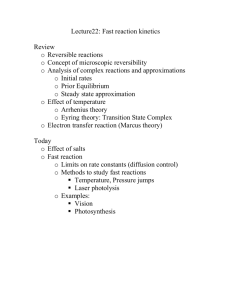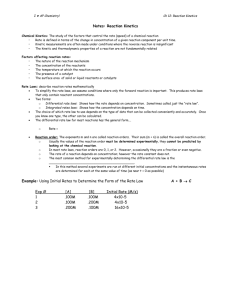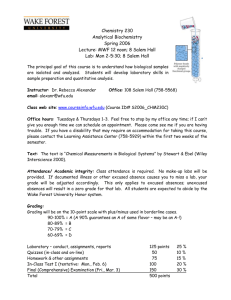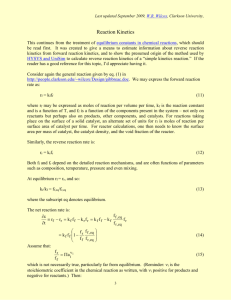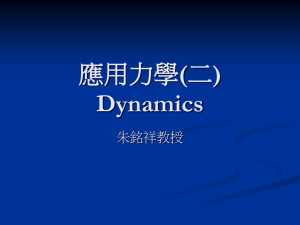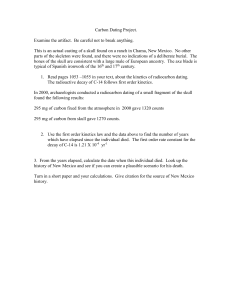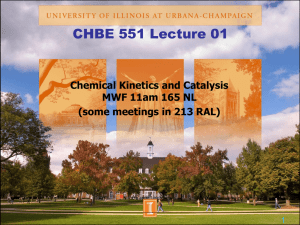Chapter-15
advertisement
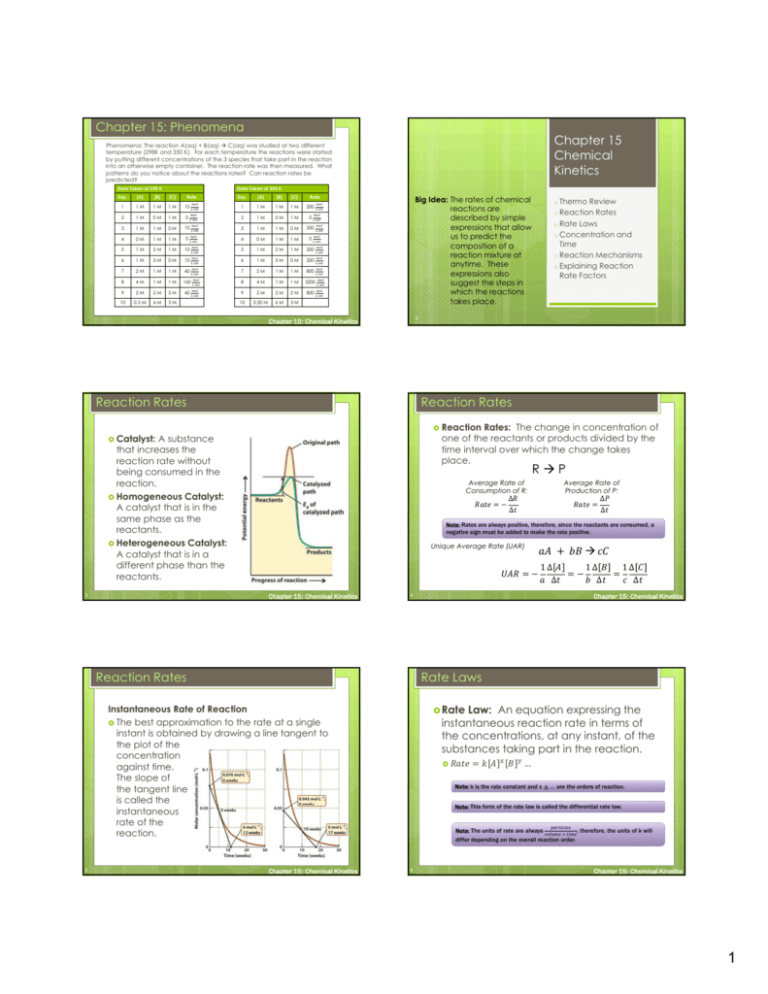
Chapter 15: Phenomena Chapter 15 Chemical Kinetics Phenomena: The reaction A(aq) + B(aq) C(aq) was studied at two different temperature (298K and 350 K). For each temperature the reactions were started by putting different concentrations of the 3 species that take part in the reaction into an otherwise empty container. The reaction rate was then measured. What patterns do you notice about the reactions rates? Can reaction rates be predicted? Data Taken at 298 K Data Taken at 350 K Exp. [A] [B] [C] Rate 1 1M 1M 1M 10 2 1M 0M 1M 0 3 1M 1M 0M 10 1M 0 4 0M 1M 5 1M 2M 1M 10 6 1M 3M 0M 10 7 2M 1M 1M 40 8 4M 1M 1M 160 9 2M 2M 2M 40 10 0.5 M 6M 3M Exp. [A] [B] [C] 1 1M 1M 1M 200 Rate 2 1M 0M 1M 0 3 1M 1M 0M 200 1M 0 Big Idea: The rates of chemical reactions are described by simple expressions that allow us to predict the composition of a reaction mixture at anytime. These expressions also suggest the steps in which the reactions takes place. 4 0M 1M 5 1M 2M 1M 200 6 1M 3M 0M 200 7 2M 1M 1M 800 8 4M 1M 1M 3200 9 2M 2M 2M 800 10 0.50 M 6M 3M o Thermo Review Rates o Rate Laws o Concentration and Time o Reaction Mechanisms o Explaining Reaction Rate Factors o Reaction 2 Chapter 15: Chemical Kinetics Reaction Rates Reaction Rates Reaction Rates: The change in concentration of one of the reactants or products divided by the time interval over which the change takes place. Catalyst: A substance that increases the reaction rate without being consumed in the reaction. Homogeneous Catalyst: A catalyst that is in the same phase as the reactants. Heterogeneous Catalyst: A catalyst that is in a different phase than the reactants. RP Average Rate of Consumption of R: Unique Average Rate (UAR) 1∆ ∆ 1∆ ∆ 1∆ ∆ Chapter 15: Chemical Kinetics 4 Reaction Rates Rate Laws Rate Law: An equation expressing the instantaneous reaction rate in terms of the concentrations, at any instant, of the substances taking part in the reaction. Instantaneous Rate of Reaction The best approximation to the rate at a single instant is obtained by drawing a line tangent to the plot of the concentration against time. The slope of the tangent line is called the instantaneous rate of the reaction. 5 ∆ ∆ Note: Rates are always positive, therefore, since the reactants are consumed, a negative sign must be added to make the rate positive. Chapter 15: Chemical Kinetics 3 Average Rate of Production of P: ∆ ∆ Chapter 15: Chemical Kinetics … Note: k is the rate constant and x ,y, … are the orders of reaction. Note: This form of the rate law is called the differential rate law. Note: The units of rate are always , therefore, the units of k will differ depending on the overall reaction order. 6 Chapter 15: Chemical Kinetics 1 Rate Laws Rate Laws How to find the units of k Step 1: Determine the order of the reaction Things to know about the rate law: Rate laws can contain products, reactants, catalysts but usually only starting material. Rate laws do not contain intermediates. Rate laws can ONLY be determined experimentally. Orders do NOT correlate with coefficients in balanced equation! Orders can be an integers, zeros, fractions, positives, OR negatives! Each species has its own individual reaction order. The overall reaction order is the sum of the individual orders found in the reaction. Examples for rate=k[A][B]: Overall order 2 Step Step 4 [A] 2 0 20 30 0 10 20 30 0 10 20 30 0.6 Rate 0.3 0.9 10 2 4 6 0 2 4 6 0 2 4 3) 6 4) Rate Law Chapter 15: Chemical Kinetics 9 1 2 3 [B]o (M) [C]o (M) Initial Rate ( 1 2 6 6 4 2 20 80 3 2 3 2 40 4 1 6 2 20 · ) General Rate Law: Order with respect to A: Order with respect to B: Order with respect to C: Chapter 15: Chemical Kinetics Rate Laws Determine the rate law and k for Determining Order (long way) Step 1: Find two experiments in which the concentrations of everything, except one species, is held constant. Step 2: Divide the rate laws for these two experiments by each other. + B 2C Experiment [A]o (M) 1 2 10 Rate Laws 2A · Determine the rate law: A + B + C 2D 2nd 6 1st 2) 0 1 Chapter 15: Chemical Kinetics 1) 0 Initial Concentration · 8 Experiment 0 Rate Laws 0th time # · Rate Laws Order 3: Find Examples for rate=k[A][B]: Chapter 15: Chemical Kinetics 7 2: Subtract 1 from the overall order Examples for rate=k[A][B]: 1 [A]o (M) [B]o (M) Initial Rate ( 0.050 0.10 0.050 0.10 0.20 0.20 0.074 0.888 0.222 · ) Note: This will cancel out k and all other variables except for the order that you are trying to determine. Math Note: Step 3: Solve for order. Math Note: It is sometimes useful to take the log of both sides of the equation. The log(xy)=ylog(x). 11 Chapter 15: Chemical Kinetics 12 Chapter 15: Chemical Kinetics 2 Rate Laws Rate Laws Determine 2A Student Question the rate law and k for The rate law for the following reaction 2NO(g) +O2(g) 2NO2(g) was experimentally found to be in the form rate=k[NO]x[O2]y It was also found that when the NO concentration was doubled, the rate of the reaction increases by a factor of 4. In addition, when both the O2 and the NO concentration were doubled, the rate increases by a factor of 8. What is the reaction order of O2? + B 2C Experiment [A]o (M) [B]o (M) Initial Rate ( 0.050 0.10 0.050 0.10 0.20 0.20 0.074 0.888 0.222 1 2 3 · ) a) 0th d) 3rd Chapter 15: Chemical Kinetics 13 Concentration and Time Determine the rate law and k for Zero + B 2C Experiment [A]o (M) 1 2 5.0 5.0 [B]o (M) 0.010 0.020 · 5.0 10. Chapter 15: Chemical Kinetics 2) 4) dA k A dt 1 3) dA kdt A A t 1 4) dA k dt A A 0 17 5) A A kt A kt A A t A 0 dA k dt Chapter 15: Chemical Kinetics 16 Concentration and Time Order Integrated Rate Law 2) dA k dt 3) dA kdt Concentration and Time 1) Rate k A dx x const ) Order Reaction: A reaction in which the rate law can be simplified because all but one of the species have virtually constant concentrations. 15 Order Integrated Rate Law 1) Rate k Initial Rate ( Pseudo First Chapter 15: Chemical Kinetics 14 Rate Laws A b) 1st c) 2nd e) None of the above Second Order Integrated Rate Law x dx ln x const 1) Rate k A 5) lnA lnA kt 2) ln A kt ln A 3) 1 Chapter 15: Chemical Kinetics 2 dA 2 k A dt 1 A2 A 2 5) 1 dx const x 1 1 A A kt dA kdt t 1 dA k dt 4) A A2 0 18 1 x 1 1 kt A A Chapter 15: Chemical Kinetics 3 Concentration and Time Concentration and Time Calculate the concentration of N2O after the first order decomposition: 2N2O(g) 2N2(g) + O2(g). The rate of decomposition of N2O = k[N2O]. The reaction has continued at 780ºC for 100. ms, and the initial concentration of N2O was 0.20 M and k = 3.4 . The rate law for A+B C + D was only found to be dependent on A. Using the following data determine the rate law and k. Time (s) Chapter 15: Chemical Kinetics 19 [A] (M) 0 5.4 20. 0.15 40. 0.077 60. 0.052 Chapter 15: Chemical Kinetics 20 Concentration and Time Concentration and Time Half Time (s) [A] (M) ln[A] [A]-1 -1 (M ) 0 5.4 1.7 0.19 20. 0.15 -1.9 6.7 40. 0.077 -2.6 13 60. 0.052 -3.0 19 6 2 25 5 1 20 3 2 1 0 [A]^-1 ln[A] [A] 4 -1 -2 20 40 60 80 1 2 A kt 1 A 2 kt 1 12 A 10 2 5 -4 0 0 0 20 Time 40 60 80 0 Time 20 40 60 80 t1 Time 2 Chapter 15: Chemical Kinetics 21 A kt A 15 -3 0 Life: Time it takes for the A concentration to drop to half the initial amount 1st Order 0th Order A A lnA kt lnA ln 12 A kt 1 lnA 2 kt 1 ln 12 A lnA 2 kt 1 ln 2 2k ln ln2 A A 1 2 t1 2 1 2 ln 2 k Chapter 15: Chemical Kinetics 22 Concentration and Time 1 2 Concentration and Time 2nd Order 1 1 kt A A 1 1 2 kt 1 2 kt 1 A 2 2 1 1 A A A t1 2 23 1 A 1 k A Chapter 15: Chemical Kinetics 24 Chapter 15: Chemical Kinetics 4 Reaction Mechanisms Reaction Mechanisms Mechanism 1: Elementary Reaction(s): Reaction Mechanism: The steps by which a reaction takes place. Mechanism Elementary Reaction: One of the reaction steps in an overall reaction. 2: Elementary Reaction(s): Note: RATE LAWS CAN BE DETERMINED FROM ELEMENTARY REACTIONS. Note: Different elementary reactions usually give different rates. Note: In order to be a valid mechanism the sum of the elementary reactions must equal the overall reaction. Note: In order to be a valid mechanism the rate law derived from the elementary reactions must match the experimentally determined rate law. Chapter 15: Chemical Kinetics 25 Chapter 15: Chemical Kinetics 26 Reaction Mechanisms Reaction Mechanisms Student Question Reaction Intermediate: A species that plays a role in the reaction but does not appear in the reaction. Use the experimentally found rate laws given below to determine which reaction is most likely to occur in a single step. Experimentally Found Rate Laws Molecularity: The number of reactant molecules/atoms taking part in an elementary reaction. a) b) c) d) Examples: → →2 ⁄ Molecularity of 1 Molecularity of 2 Chapter 15: Chemical Kinetics 27 Chapter 15: Chemical Kinetics 28 Reaction Mechanisms Reaction Mechanisms Student Question Student Question Consider the following hypothetical reaction: A + 2B E. The mechanism for this reaction is: (1) A + B C (slow) (2) B + C D (fast) (3) D E (fast) The rate law consistent with this mechanism is: a) rate=k[A][B] b) rate=k[A]2[B] c) rate=k[A]2 d) rate=k[A][B]2 e) None of the above 29 2NO2(g)+F2(g)2NO2F(g) H2(g)+Br2(g)2HBr(g) 2NO(g)+2O2(g)2NO2(g) + O2(g) NO2(g)+CO(g) NO(g) + CO2(g) Chapter 15: Chemical Kinetics The reaction 2NO + Cl2 2NOCl was experimentally found to have the rate law: rate = k[Cl2][NO]2. Which mechanism could not be the correct mechanism? a) Cl2 ⇌ 2Cl (fast equilibrium) 2Cl + 2NO 2NOCl (slow) b) 2NO + 2Cl2 2NOCl2 (slow) 2NOCl2 ⇌ NOCl3+NOCl (fast equilibrium) NOCl3 ⇌ NOCl + Cl2 (fast equilibrium) c) 2NO + Cl2 2NOCl d) 2NO ⇌ N2O2 (fast equilibrium) N2O2 + Cl2 2NOCl (slow) e) All of the above are possible mechanisms 30 Chapter 15: Chemical Kinetics 5 Reaction Mechanisms Relating Reaction Mechanisms the Rate and Equilibrium Constants A+B ⇌ C Multi Step Reactions With Unknown Speeds At Equilibrium (Rateforward = Ratereverse) K Step 1: Write an expression for the rate of formation of one of the final products (sometimes the product of interest is specified). If possible select a product that is only in 1 step. Rate Constant Equilibrium Constant Step 2: Use the steady state approximation to solve for the concentration of intermediates. C k1 A B k1 K Step k1 k1 Chapter 15: Chemical Kinetics 31 Explaining Reaction Rate Factors Collision Theory (Gases Only) Student Question The rate constant for the second-order gasphase reaction HO(g) + H2(g) H2O(g) + H(g) varies with the temperature as shown here: Rate Constant ( 373 1.1×10-9 473 1.8×10-8 573 1.2×10-8 673 4.4×10-7 · Rate = Collision Frequency × Fraction with Sufficient Energy How would we get collision frequency Size of the molecules/atoms Average velocity of the molecules/atoms Concentration of molecules/atoms ) How would we get fraction with sufficient energy? Boltzmann distribution Determine the activation energy. b) 4.0×103 a) 2.4×10-5 4 c) 4.2×10 d) None of the above Chapter 15: Chemical Kinetics 33 Chapter 15: Chemical Kinetics 32 Explaining Reaction Rate Factors Temperature (K) 3: Plug back into overall rate equation. 4 Chapter 15: Chemical Kinetics 34 Explaining Reaction Rate Factors ⁄ Explaining Reaction Rate Factors Activated Problem: Although the rate has the right form (Arrhenius) it predicts a larger reaction rate than is found. Solution: Sterics need to be taken into account. Complex Theory (Solutions) Ea = Minimum energy needed for reaction to occur. A = Takes into account number of collisions and sterics. 35 Chapter 15: Chemical Kinetics 36 Chapter 15: Chemical Kinetics 6 Take Away From Chapter 15 Take Away From Chapter 15 Big Idea: The rates of chemical reactions are described by simple expressions that allow us to predict the composition of a reaction mixture at anytime. These expressions also suggest the steps in which the reactions takes place. Know the difference between thermo and kinetics Thermodynamics allows us to predict if a reaction will occur. Kinetics allows us to predict how fast a reaction will occur. Be able to draw reaction coordinates along with labeling reactants, products, intermediates, transition states, and activation energy. (80, 81, 82) Reaction Rates Be able to calculate the average rate of reaction of 1 species given the average rate of reaction of another species. Be able to calculate the unique average rate of a reaction. Rate Law Thermo Review Reaction Rates (Continued) Be able to explain how a catalyst can increase reaction rate. (84, 88) Know that rate laws must be determined experimentally. Be able to determine the order of a reaction and each individual species. Be able to calculate rate law from experimental data. (17, 18, 19, 20, 21) Double concentration and rate stays the same: 0th order Double concentration and rate doubles: 1st order Double concentration and rate quadruples: 2nd order If none of these use the math trick Be able to determine the units of the rate constant (8, 14, 15) The units of concentration are constant (M) The units of rate are constants Numbers correspond to end of chapter questions. Chapter 15: Chemical Kinetics 37 Take Away From Chapter 15 Chapter 15: Chemical Kinetics Take Away From Chapter 15 Rate Law (Continued) Know that rate problems can be simplified when the concentration of 1 species is high and essentially unchanging (pseudo order reactions). (34, 37, 50) Be able to use the integrated rate law to perform calculations. (41, 45, 46, 48) 0th order: ° 1st order: ln ° 2nd order: Be able to identify the order of the reaction by plotting data. (28, 29, 30, 31, 33, 36) [A] vs. t linear 0th order, slope = -k ln[A] vs. t linear 1st order, slope= -k [A]-1 vs. t linear 2nd order, slope = k Be able to calculate half-life/2nd half-life/etc.. Be able to write a rate law of an elementary reaction. (55) Be able to determine the rate law of multi step reactions. (56,57) Be able to eliminate intermediates from multi step reactions. Equilibrium (59,61,64) Steady state approximation (65,66) Explaining Reaction Rate Factors ° Reaction Mechanisms (52) Concentration and Time Concentration Catalyst Be able to draw potential energy diagram of reactions Temperature Know that most reactions follow Arrhenius behavior. (68,73,74,65,75,77,78,) Chapter 15: Chemical Kinetics ln ln Numbers correspond to end of chapter questions. Numbers correspond to end of chapter questions. 39 · Numbers correspond to end of chapter questions. 38 40 Chapter 15: Chemical Kinetics Take Away From Chapter 15 Explaining Reaction Rate Factors (continued) Surface Area Know the ideas behind collision theory (gases). Know the ideas behind activated complex theory (solutions). Numbers correspond to end of chapter questions. 41 Chapter 15: Chemical Kinetics 7



